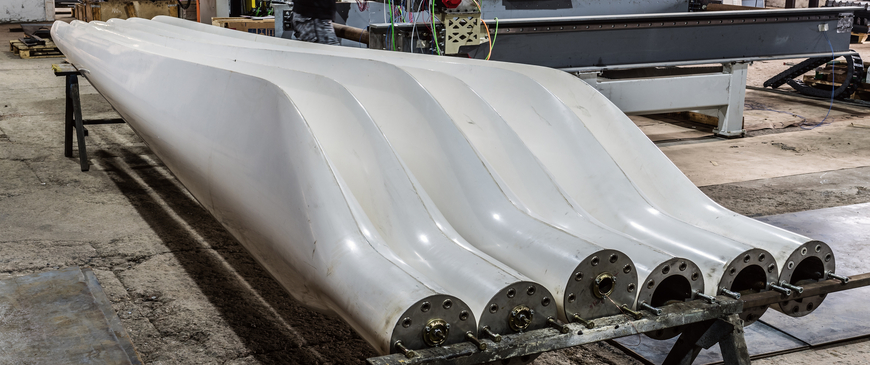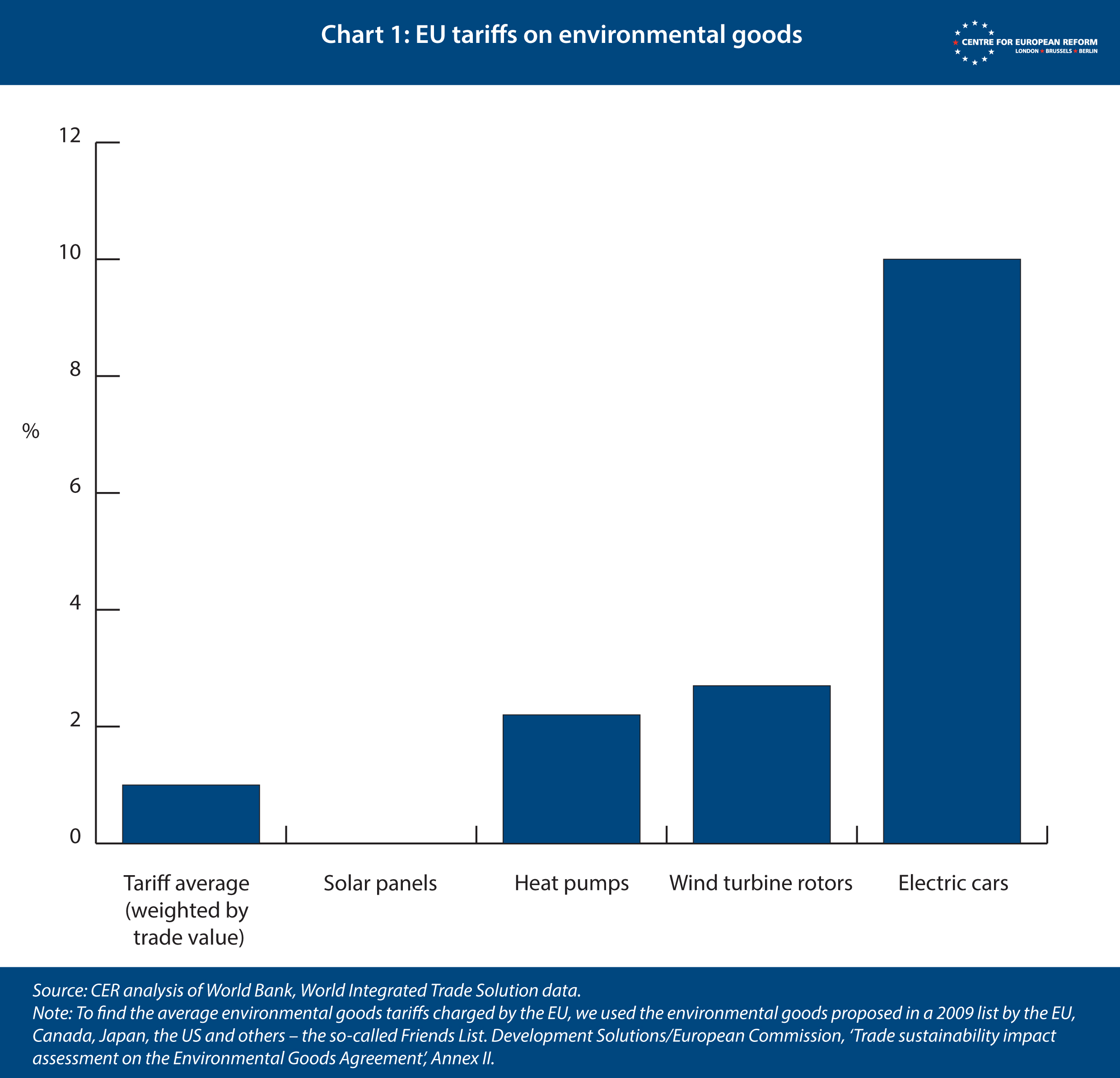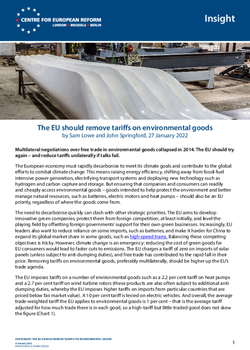
The EU should remove tariffs on environmental goods
Multilateral negotiations over free trade in environmental goods collapsed in 2014. The EU should try again – and reduce tariffs unilaterally if talks fail.
The European economy must rapidly decarbonise to meet its climate goals and contribute to the global efforts to combat climate change. This means raising energy efficiency, shifting away from fossil-fuel intensive power generation, electrifying transport systems and deploying new technology such as hydrogen and carbon capture and storage. But ensuring that companies and consumers can readily and cheaply access environmental goods – goods intended to help protect the environment and better manage natural resources, such as batteries, electric motors and heat pumps – should also be an EU priority, regardless of where the goods come from.
The need to decarbonise quickly can clash with other strategic priorities. The EU aims to develop innovative green companies, protect them from foreign competition, at least initially, and level the playing field by offsetting foreign governments’ support for their own green businesses. Increasingly, EU leaders also want to reduce reliance on some imports, such as batteries, and make it harder for China to expand its global market share in some goods, such as high-speed trains. Balancing these competing objectives is tricky. However, climate change is an emergency: reducing the cost of green goods for EU consumers would lead to faster cuts to emissions. The EU charges a tariff of zero on imports of solar panels (unless subject to anti-dumping duties), and free trade has contributed to the rapid fall in their price. Removing tariffs on environmental goods, preferably multilaterally, should be higher up the EU’s trade agenda.
Reducing the cost of green goods to EU consumers would lead to faster cuts to emissions.
The EU imposes tariffs on a number of environmental goods such as a 2.2 per cent tariff on heat pumps and a 2.7 per cent tariff on wind turbine rotors (these products are also often subject to additional anti-dumping duties, whereby the EU imposes higher tariffs on imports from particular countries that are priced below fair market value). A 10 per cent tariff is levied on electric vehicles. And overall, the average trade-weighted tariff the EU applies to environmental goods is 1 per cent – that is the average tariff adjusted for how much trade there is in each good, so a high-tariff but little-traded good does not skew the figure (Chart 1).

While in practice the tariff applied to many imports will be lower due to the EU’s extensive network of free trade agreements (FTAs), the average tariff for environmental goods remains higher than it should be, creating unnecessary costs for EU businesses and consumers. According to a 2014 impact assessment conducted for the European Commission, eliminating these tariffs would reduce carbon dioxide emissions by 10 million tonnes by 2030, reducing the carbon intensity of EU GDP by 0.02 per cent – a small amount, but every little helps. The same study found that consumer prices of these goods would fall by 0.8 per cent on average.
Global efforts to facilitate trade in environmental goods have faltered. In 2014, 46 members of the World Trade Organisation (WTO), including the EU, began negotiations for an environmental goods agreement (EGA). Their ambition was to identify goods that served an environmental purpose and remove any tariffs applied to them. However, the talks collapsed in 2016: negotiators could not agree, among other things, on a list of environmental goods. The infamous example was a dispute between China and the EU over whether bicycles were an environmental good (China said yes; the EU no). In addition, it proved hard to agree on how to deal with ‘dual-use’ goods, which can be used for both environmental and polluting purposes, such as car parts that can be used in either low- or high-emissions engines. Finally, the negotiating parties were concerned about potential free-riding by non-participating countries, which would be able to export tariff-free to participating countries, even if they refused to eliminate their own tariffs.
However, the topic of trade and the environment is moving up the multilateral agenda: there is growing momentum to restart the EGA negotiations as part of wider talks known as the Trade and Environmental Sustainability Structured Discussions (TESSD), an initiative of 57 parties including the EU to press for “a global system that protects and preserves the environment in accordance with sustainable development” at the WTO. But even if the negotiations were to restart, there is no guarantee they would conclude. Green technologies have moved on rapidly since 2014, and definitions of environmental goods have changed: ‘clean diesel’ engines would no longer be considered, as they had been in the first EGA talks. And the EU (and others) continue to view retaining tariffs on environmental goods such as electric vehicles and batteries as being in their longer-term industrial and strategic interest, even when removing them would facilitate faster emission cuts.
It is in the bloc’s environmental interest for batteries to be produced as cheaply as possible.
In the absence of multilateral agreement – which would take years to enter into force even under optimistic assumptions – the EU should, at the very least, expand the number of environmental goods it zero-rates. On top of the product lines included in the original EGA negotiations, the EU should follow the UK’s example after it left the EU, and remove tariffs on an additional 133 environmental goods – although, the UK notably retained the 10 per cent tariff on electric/hybrid vehicles and the 14 per cent tariff on bicycles. The EU should also consider joining with smaller groups of like-minded countries, such as New Zealand, Norway, Switzerland, Costa Rica and Fiji, under the banner of the Agreement on Climate Change, Trade and Sustainability – to agree more rapid liberalisation of trade in both environmental goods and services.
Such tariff reductions, and trade liberalisation in general, will always provoke opposition from domestic producers, sometimes with good reason. Cheap solar panels from China, for example, have long been subject to EU anti-dumping tariffs in order to offset Chinese subsidies and protect the competitiveness of the European solar industry. And in some instances – such as electric vehicles and batteries – the EU’s climate agenda might clash with the Union’s other priorities, including the push for EU strategic autonomy.
It is in the bloc’s environmental interest for batteries to be produced as cheaply as possible, in order to drive down the cost of the green transition. However, France, Germany, Spain and other EU states are concerned about Europe’s reliance on China as a source of batteries. They view the creation of a European alternative as a strategic imperative, and as necessary to retain public support for tougher climate policies, which will disrupt existing industry and displace some workers. Since October 2017, the EU’s collaborative effort to onshore battery production has existed under the auspices of the European Battery Alliance.
Electric cars are another case in point. A ten per cent tariff is applied to imported electric vehicles (EVs), pushing up the cost to consumers. And not only are non-EU batteries subject to a tariff of 2.7 per cent, but the EU’s FTAs also penalise electric vehicles that are traded under them. This is because the rules of origin criteria in most of the EU’s FTAs condition tariff-free trade on 50-60 per cent of a vehicle being produced within the EU or the partner country, and batteries, which are usually made in Asia, can account for up to 45 per cent of an electric vehicle’s final value. As a result, trade in electric vehicles between FTA signatories often fail to qualify for zero tariffs. This bias against EVs serves to both pressure the European car industry into developing an onshore battery supply chain and, perversely, makes it more attractive for some of the EU’s FTA partners to produce and export petrol and diesel vehicles to the EU, rather than EVs.
The use of tariffs and rules of origin as a deliberate tool of EU industrial policy was made explicit in the EU’s post-Brexit trade deal with the UK. Following a phase-in period, 55 per cent of an electric vehicle’s value will need to be created locally for it to qualify for tariff-free trade between the EU and the UK. The vehicle’s battery and its components – including the active cathode material used to make cells – will also need to be manufactured in the EU or the UK. Such provisions, if included in future FTAs, may increase battery-related investment and capacity within the EU. But they will also push up the cost of batteries and EVs, at the expense of the EU’s climate goals.
The usual arguments against trade barriers apply to environmental goods – that they raise costs for consumers and make us all poorer, especially in developing countries, by preventing production from taking place in countries where it can be done most cheaply. But such arguments are given more force by the need to decarbonise as quickly and cheaply as possible. As a hypothetical example, US battery plants might end up being more productive than EU ones, or the batteries they produce might be more efficient, because of a breakthrough innovation by Tesla or a start-up. By reducing or eliminating tariffs on batteries, European consumers would gain faster access to this technology.
Tariffs are a bad tool to use to promote innovation and investment in green technology.
Tariffs are also a bad tool to use to promote innovation and investment in green technology. It is far better to subsidise early-stage tech and ensure that there is cheap financing available to allow businesses with proven technology to scale up quickly. The car industry might be such an important industry for the EU that politically, zero tariffs are impossible. But the logic of free trade extends to heat pumps, turbines and electric bicycles, and the EU should reduce or remove tariffs unilaterally where it can, if multilateral negotiations founder.
Sam Lowe is director, trade at Flint Global and John Springford is deputy director of the Centre for European Reform.
This work is being supported by a grant from the European Climate Foundation.
The authors would like to thank Megan Ferrando for research assistance.


Add new comment